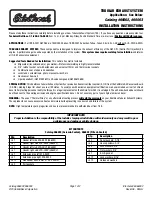
Carrying children safely
Vehicle equipment
This chapter describes all standard, country-spe‐
cific and special equipment available for the
model series. It may therefore describe equip‐
ment and functions which are not installed in
your vehicle, for example on account of the op‐
tional equipment selected or the country variant.
This also applies to safety-relevant functions and
systems. Please comply with the relevant laws
and regulations when using the corresponding
functions and systems.
Important considerations
Safety note
WARNING
Unsupervised children or pets in the vehicle
can set the vehicle in motion and endanger
themselves or other road users, for example by
the following actions:
▷ Pressing the start/stop button.
▷ Releasing the parking brake.
▷ Opening and closing doors or windows.
▷ Engaging selector lever position N.
▷ Operating vehicle equipment.
There is a risk of accidents or injury. Do not
leave children or pets unsupervised in the vehi‐
cle. When leaving the vehicle, take the vehicle
key with you and lock the vehicle.
Children always in the rear seats
General
Accident research has shown that the safest
place for children is on the rear seat.
Children younger than 12 years old or under
150 cm, 5 ft tall are only allowed to be transpor‐
ted in the rear using child restraint systems ap‐
propriate for their age, weight and stature. Chil‐
dren aged 12 years and older must be secured
with a seat belt as soon as a suitable child re‐
straint system is no longer appropriate due to
their age, weight or stature.
Safety note
WARNING
Children under 150 cm, 5 ft tall cannot wear
the seat belt correctly without using additional
child restraint systems. The protective function
of the seat belts may be limited or may even fail
completely if the seat belts are worn incorrectly.
If a seat belt is not worn correctly, additional in‐
juries can be caused, for example in the event
of an accident or when braking or carrying out
evasive manoeuvres. There is a danger of injury
or even death. Children under 150 cm, 5 ft tall
must be secured in suitable child restraint sys‐
tems.
Children on the front passenger
seat
General
When using a child restraint system on the front
passenger seat, make sure that the front and
side airbags on the passenger side are deactiva‐
ted. Front passenger airbags can only be deacti‐
vated with the key switch for front passenger air‐
bags, see page
. If the front passenger
airbags cannot be deactivated, do not carry chil‐
dren on the front passenger seat, even in suita‐
ble child restraint systems.
Seite 129
Carrying children safely
CONTROLS
129
Online Edition for Part no. xxx - VI/19
Summary of Contents for 318D
Page 2: ...Online Edition for Part no xxx VI 19...
Page 6: ...6 Online Edition for Part no xxx VI 19...
Page 7: ...NOTES Notes 8 Owner s Handbook media 18 7 Online Edition for Part no xxx VI 19...
Page 20: ...20 Online Edition for Part no xxx VI 19...
Page 37: ...On the move QUICK REFERENCE 37 Online Edition for Part no xxx VI 19...
Page 38: ...38 Online Edition for Part no xxx VI 19...
Page 312: ...312 Online Edition for Part no xxx VI 19...
Page 332: ...332 Online Edition for Part no xxx VI 19...
Page 397: ...General care MOBILITY 397 Online Edition for Part no xxx VI 19...
Page 398: ...398 Online Edition for Part no xxx VI 19...
Page 411: ...Appendix REFERENCE 411 Online Edition for Part no xxx VI 19...
Page 427: ...BL00I xxx en...
Page 428: ......
















































